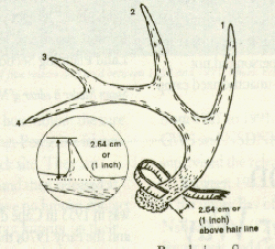
by: Susan Mader
FALL 1984
Managing Nova Scotia's wildlife for the benefit of all Nova Scotians is the responsibility of the Department of Lands and Forestry . Information is the key to carrying out this responsibility. Because hunters are out in the woods for extended periods of time, hunting, watching, and listening to wildlife, they are one of DNR's most valuable sources of information about wildlife species.
Nova Scotia deer hunters take an active part in the management of the province's deer herd. every year hunters are asked to turn in the lower jawbone of their deer, which is used to determine the animal's age. Last year, DNR had the highest-ever rate of return of jawbones - 20 percent of the number of deer taken by hunters.
Department staff carry out pellet group inventory counts, which suggest the size of the herd. Staff also examine the bone marrow of road kill deer. This information is evaluated to determine the herd's condition.
The deer population is still relatively low in number compared to past years, even after last year's Buck Law. The Buck Law will be in effect again during this fall's hunting season, from October 28 to December 3. Hunters will only be allowed to hunt bucks- mature, antlered, male deer.
Beginning this year, Natural Resources is carrying out a new project that requires assistance from hunters. The source of the information and the tool to do the task are readily at hand, and it will only take a few minutes of the hunter's time. Using the little strip at the bottom of the deer license, hunters are being asked to measure the circumference of the deer's antler and to count the number of points on each antler.
Tony Nette, Wildlife Manager of Big Game for the department, says through research and studies, it has been determined that antler size can be used as an indicator of herd condition. By working with DNR staff, thousands of hunters are contributing to the management of this resource.
"Deer are an animal virtually impossible to count due to their behaviour and the economics of surveying by helicopter," he says.
With this antler information provided to the department, staff can predict how the herd will survive the winter in normal, mild, or severe conditions. Research has shown that if habitat conditions are good, a deer's body growth will increase. The antlers of a deer in good conditions will also be larger. If the snow is deep and the temperatures cold, deer will have a difficult time finding enough food to survive the winter. They will be undernourished and may not survive, let alone give birth to strong and healthy fawns in the spring. By recording information about the antlers of a large enough number of bucks, an indication of the general condition of the herd can be determined.
As in past years, a strip tears off the bottom of the license to tie the tag to the carcass. This year a measuring tape has been printed on this strip so it can also be used to measure the circumference of the antlers.
Hunters should measure the distance around the antler beam approximately 2.5 cm (1 in.) above the hair line. This number is recorded in the Hunting Regulations Summary, which every licensed hunter receives. The next step is to count the number of antler points on each antler and record the total in the Summary as well. Antler points less than 2.5 cm (1 in.) in length are not counted (see illustration).

This information should be turned in with the lower jawbone at a DNR district office. Without the jawbone, the antler measurements are of little value. The information enables department staff to assess herd condition so that the deer herd can be managed more effectively, ensuring its enjoyment for future generations.